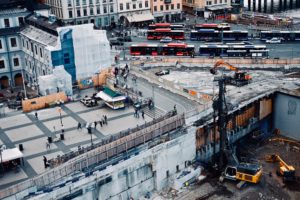What is a Seismic Retrofit?
 Seismic activity is not foreign to California where, according to California’s Department of Conservation, significant earthquakes of magnitude 5.5 and higher occur two or three times per year.
Seismic activity is not foreign to California where, according to California’s Department of Conservation, significant earthquakes of magnitude 5.5 and higher occur two or three times per year.
Therefore, seismic retrofit programs were put in place to ensure the reinforcement of more vulnerable buildings built prior to 1977. At Permit Advisors, our Project Managers have tackled several permit processes related to seismic retrofits such as structural permits and fault line investigations.
Before we go into detail on the permits themselves, let’s discuss what a seismic retrofit is. A seismic retrofit is a process where an existing structure is reinforced to resist damage from an earthquake. According to the Los Angeles Division of Building & Safety (LADBS), the goal of a seismic retrofit program is to reduce structural deficiencies and improve the performance of buildings during earthquakes. They are completed to keep building occupants safe and to ensure the building’s longevity and structural integrity during a seismic event.
Where does Permit Advisors come in?
While seismic retrofits often pertain to essential buildings such as hospitals or historical properties, we don’t typically work with these cases. In terms of seismic retrofits, we typically work with permits pertaining to renovations of commercial properties, such as retail stores and office buildings.
Existing Buildings
When retrofitting a building, you are essentially increasing the structural integrity of that building. For example, you may be strengthening beams, adding steel bracing, and/or reinforcing concrete. Completing work of this nature requires structural permits. A structural permit is a type of a building permit. In most jurisdictions, a building review will be required to obtain this type of permit. Permit Advisors is familiar with the complexity of the review process and can support our clients immensely by taking the process off their hands.
New Developments
 In the state of California, you cannot build a new building on top of, or within a certain distance of, an active fault line. Therefore, developers interested in building in or near a fault zone must conduct a fault line investigation to determine whether there are any faults in the earth below the parcel of land. This investigation involves drilling large holes into the earth and conducting a series of major tests called cone penetration tests, borings, and trenches. Work of this nature requires approvals and permits prior to being conducted. Permit Advisors supports our clients throughout the process of obtaining excavation permits, right-of-way permits, after-hour permits, and more.
In the state of California, you cannot build a new building on top of, or within a certain distance of, an active fault line. Therefore, developers interested in building in or near a fault zone must conduct a fault line investigation to determine whether there are any faults in the earth below the parcel of land. This investigation involves drilling large holes into the earth and conducting a series of major tests called cone penetration tests, borings, and trenches. Work of this nature requires approvals and permits prior to being conducted. Permit Advisors supports our clients throughout the process of obtaining excavation permits, right-of-way permits, after-hour permits, and more.
Facilitating Between City & Client
Permits related to seismic retrofits and fault line investigations are very extensive and require a great deal of communication back-and-forth between city officials, developers, architects, engineers, and geologists. We understand the importance of communication and following-up between parties and have a team of project managers dedicated to doing just that.
